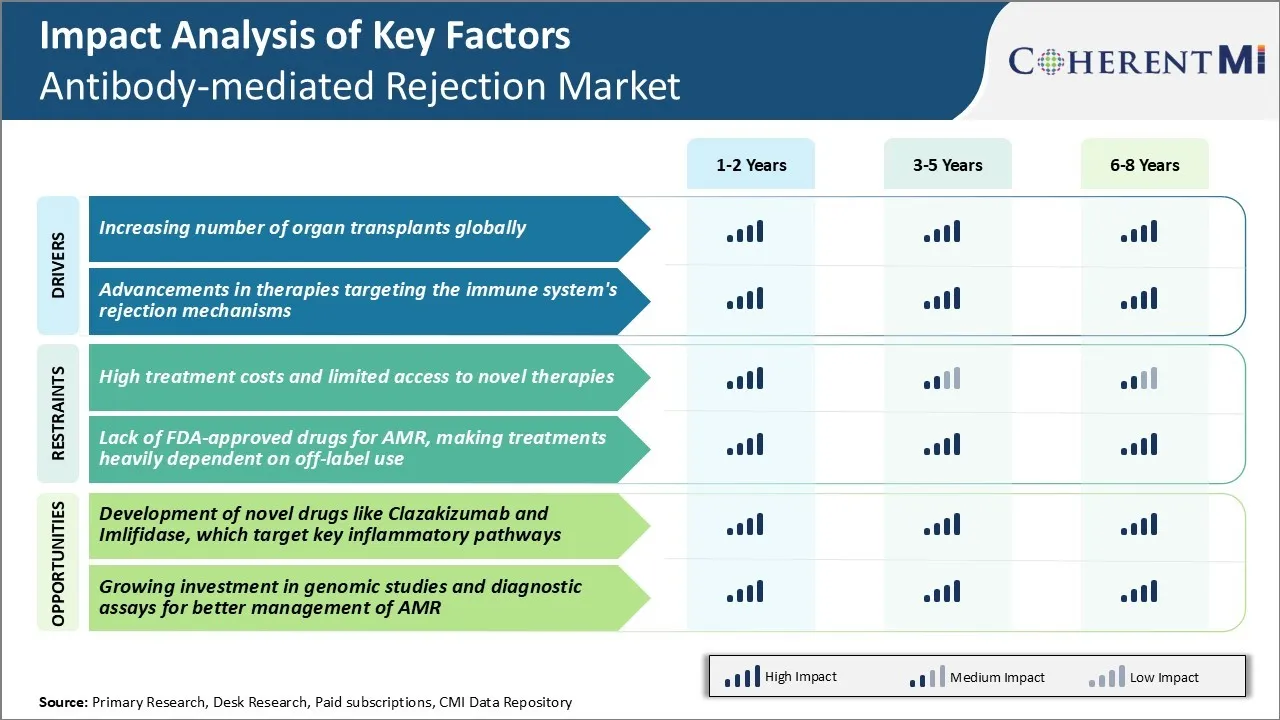Antibody-mediated Rejection Market Size - Analysis
Market Size in USD Mn
CAGR12.64%
| Study Period | 2024 - 2031 |
| Base Year of Estimation | 2023 |
| CAGR | 12.64% |
| Market Concentration | High |
| Major Players | CSL Behring, Hansa Biopharma AB, Viela Bio, Janssen Biotech, Pfizer and Among Others |
please let us know !
Antibody-mediated Rejection Market Trends
Growing awareness about organ donation, coupled with state-of-the-art surgical techniques, have enabled doctors to successfully carry out complex transplant procedures on a regular basis now. This has significantly boosted the total number of organ transplants performed worldwide each year. For instance, data from the Organ Procurement and Transplantation Network (OPTN) in the United States shows that the volumes have steadily increased over the past decade, with over 40,000 transplants done in 2021 alone.
Pharmaceutical companies are investing heavily in developing more effective and targeted immunosuppressants that can help improve transplant outcomes. Some newer agents even aim to induce immunotolerance, allowing transplant patients to eventually get off immunosuppression in the long run. All these factors point towards a continuously expanding patient pool who may potentially require lifelong anti-rejection medications, thus propelling the associated market forward.
Market Driver - Advancements in Therapies Targeting the Immune System's Rejection Mechanisms
Some examples include biological drugs inhibiting specific co-stimulatory molecules on immune cells or antibodies neutralizing inflammatory cytokines released during allograft rejection. Clinical studies evaluating these biologics show effective suppression of immune activation without broad suppression, translating to improved graft function and patient survival. Another promising arena is gene therapy whereby introduction or silencing of certain genes can help generate antigen-specific non-responsiveness or operational tolerance towards transplanted organs. Such targeted strategies are anticipated to replace conventional non-specific immunosuppressants over the long run.

Market Challenge - High treatment costs and limited access to novel therapies
A major opportunity in the antibody-mediated rejection market lies in the development of novel drugs that target key inflammatory pathways associated with the condition. For instance, Clazakizumab is a monoclonal antibody against IL-6 that has shown promise in reducing acute rejection episodes in clinical trials. IL-6 is a major pro-inflammatory cytokine implicated in antibody-mediated injury to transplanted organs.
As novel mechanisms of action, Clazakizumab and Imlifidase have potential to deliver superior clinical outcomes compared to existing therapies. Their approval in the coming years could help address unmet needs in patient subgroups with high antibody levels.
Prescribers preferences of Antibody-mediated Rejection Market
Antibody-mediated rejection (AMR) is commonly treated through a step-wise approach based on severity and stage of rejection. For mild AMR early after transplantation, prescribers typically start with increased immunosuppression using medications like tacrolimus (Prograf), mycophenolate mofetil (CellCept), and corticosteroids.
For cases still unresponsive to first-line treatment or those presenting with more severe acute AMR, prescribers often use rituximab (Rituxan) - a monoclonal antibody targeting B cells. This second-line therapy aims to deplete antibody-producing cells. Non-responders or those with chronic, active AMR may progress to third-line options like bortezomib (Velcade), a proteasome inhibitor with mechanistic benefits, or eculizumab (Soliris), a complement inhibitor targeting inflammation pathways.
Treatment Option Analysis of Antibody-mediated Rejection Market
Antibody-mediated rejection (AMR) has three main stages - subclinical, clinical, and chronic active AMR. For subclinical AMR, the preferred first-line treatment involves the use of intravenous immunoglobulin (IVIG). IVIG works by suppressing antibody production and is generally well-tolerated.
In cases where first-line therapy fails or for chronic active AMR, second-line treatments such as bortezomib, eculizumab or rituximab are used. Bortezomib is a proteasome inhibitor that suppresses plasma cells producing antibodies. Eculizumab blocks terminal complement system to prevent tissue damage from AMR. Rituximab depletes B-cells, reducing new antibody production.
Key winning strategies adopted by key players of Antibody-mediated Rejection Market
Focus on innovative drug development - Companies like Bristol-Myers Squibb and Alexion Pharmaceuticals have invested heavily in R&D to develop novel therapeutic antibodies targeting specific pathways involved in AMR. For example, in 2020, Bristol-Myers Squibb's belimumab (Benlysta) received FDA approval for the treatment of AMR in kidney transplant recipients.
Focus on real-world evidence generation - Companies provide support for large longitudinal studies and clinical registries that help generate real-world evidence on treatment patterns and outcomes. For example, data from the National Transplantation Pregnancy Registry established with Bristol-Myers Squibb's support showed belimumab was well-tolerated in transplant recipients, supporting its approval and adoption.
Segmental Analysis of Antibody-mediated Rejection Market
In terms of treatment, plasma exchange is expected to account for 35.3% share of the antibody-mediated rejection market in 2024, owning to its widespread availability and proven clinical efficacy. As an apheresis procedure, Plasma Exchange technology is well established in hospitals and transplantation centers globally. The equipment and disposables required for plasma exchange are standardized and produced by several major medical device companies, ensuring reliable access.
The procedure is also generally well-tolerated with a relatively safe side effect profile. Moreover, experience with plasma exchange among clinicians performing renal transplants provides heightened familiarity and comfort prescribing it. The combined factors of broad availability, clinical evidence, supplier network, practicality of use and familiarity amongst medical professionals have made Plasma Exchange the segment leader in antibody removal therapy.

In terms of drugs in development, Clazakizumab contributes the highest share of the antibody-mediated rejection market due to emerging efficacy data from clinical trials. Clazakizumab is a monoclonal antibody that inhibits the pro-inflammatory cytokine interleukin-6 (IL-6). Beyond its immunomodulatory effects, preclinical research indicates IL-6 plays a direct role in promoting antibody production. An ongoing Phase 2 clinical study is evaluating Clazakizumab for preventing antibody-mediated rejection in kidney transplant recipients.
The promising results to date have generated substantial interest within the transplantation community and piqued investors’ attention for this first-in-class mechanism. Barring any safety concerns in subsequent trials, Clazakizumab seems well positioned to become the leading therapeutic in this segment pending regulatory approvals.
Insights, By Therapeutic Approach: Superior Target Specificity Drives Monoclonal Antibodies in Antibody-mediated Rejection Therapeutic Approaches
For example, anti-CD20 antibodies selectively deplete B cells responsible for alloantibody secretion without fully ablating humoral immunity. Complement inhibitors provide a less precise approach by broadly inhibiting multiple complement activation pathways throughout the body.
Additionally, many transplantation centers employ low-dose IVIG preparations enriched for anti-CD20 to deplete long-lived plasma cells in refractory cases. The precision these targeted biological therapies afford coupled with improving recombinant antibody manufacturing techniques continue driving interest and segment share for monoclonal antibodies in Antibody-mediated Rejection treatment.
Additional Insights of Antibody-mediated Rejection Market
- AMR represents a spectrum of conditions coexisting with T-cell-mediated rejection, often leading to allograft loss and characterized by donor-specific antibodies.
- The US leads the antibody-mediated rejection cases in the 7MM, representing over 60% of total cases.
- Kidney, lung, and liver transplant cases were the top contributors to antibody-mediated rejection cases in the 7MM in 2023.
- France had the highest number of antibody-mediated rejection cases in the EU4.
- Antibody-mediated rejection affects approximately 5-7% of all kidney transplants, with acute AMR being particularly challenging to treat due to the variability in patient response. The lack of standardized treatment guidelines further complicates patient management, with therapies largely based on off-label use from other areas of medicine.
Competitive overview of Antibody-mediated Rejection Market
The major players operating in the antibody-mediated rejection market include CSL Behring, Hansa Biopharma AB, Viela Bio, Janssen Biotech, Pfizer, Sanofi, HI-Bio, and Horizon Therapeutics.
Antibody-mediated Rejection Market Leaders
- CSL Behring
- Hansa Biopharma AB
- Viela Bio
- Janssen Biotech
- Pfizer
Antibody-mediated Rejection Market - Competitive Rivalry

Antibody-mediated Rejection Market
(Dominated by major players)
(Highly competitive with lots of players.)
Recent Developments in Antibody-mediated Rejection Market
- In March 2024, Human Immunology Biosciences (HI-Bio) announced that the U.S. Food and Drug Administration (FDA) granted Orphan Drug Designation to felzartamab for the treatment of antibody-mediated rejection (AMR) in kidney transplant recipients. This designation is a significant step for the development of felzartamab, a monoclonal antibody that targets CD38+ plasma cells, which play a key role in AMR. The Orphan Drug Designation helps to promote the development of treatments for rare diseases, offering incentives like tax credits and market exclusivity upon approval.
- In January 2024, Hansa Biopharma AB published positive results from its Imlifidase trials, focusing on acute AMR cases where conventional treatments failed, marking a breakthrough in treatment options for transplant recipients. The trials demonstrated that imlifidase significantly reduced donor-specific antibodies (DSAs) within five days of treatment, marking a significant breakthrough for transplant recipients facing rejection where conventional treatments had failed. This is particularly important for patients with AMR, a leading cause of graft failure, as there are currently no approved therapies for this condition. The promising results from these phase 2 trials showed that imlifidase was more effective and faster at reducing DSAs compared to traditional plasma exchange treatments.
- In May 2023, CSL Behring advanced Clazakizumab into Phase III clinical trials to investigate its potential in treating chronic active antibody-mediated rejection (AMR) in kidney transplant recipients. This is a critical area of research because AMR is a leading cause of late kidney graft loss, and current treatment options are limited.
- In October 2018, the U.S. Food and Drug Administration (FDA) granted Fast Track Designation to imlifidase, a drug developed by Hansa Biopharma, for investigating its use in transplantation. Specifically, imlifidase is being studied for its potential to enable kidney transplantation in highly sensitized patients by inactivating harmful antibodies that can otherwise cause organ rejection.
Antibody-mediated Rejection Market Segmentation
- By Treatment
- Plasma Exchange
- IVIG
- Complement Inhibitors
- Proteasome Inhibitors
- By Drugs in Development
- Clazakizumab
- Imlifidase
- By Therapeutic Approach
- Monoclonal Antibodies
- Complement Inhibitors
- By Patient Type
- Pre-sensitized Transplant Recipients
- Acute AMR Patients

Would you like to explore the option of buying individual sections of this report?
Ghanshyam Shrivastava - With over 20 years of experience in the management consulting and research, Ghanshyam Shrivastava serves as a Principal Consultant, bringing extensive expertise in biologics and biosimilars. His primary expertise lies in areas such as market entry and expansion strategy, competitive intelligence, and strategic transformation across diversified portfolio of various drugs used for different therapeutic category and APIs. He excels at identifying key challenges faced by clients and providing robust solutions to enhance their strategic decision-making capabilities. His comprehensive understanding of the market ensures valuable contributions to research reports and business decisions.
Ghanshyam is a sought-after speaker at industry conferences and contributes to various publications on pharma industry.
Frequently Asked Questions :
How big is the antibody-mediated rejection market?
The antibody-mediated rejection market is estimated to be valued at USD 126.5 Mn in 2024 and is expected to reach USD 291.1 Mn by 2031.
What are the key factors hampering the growth of the antibody-mediated rejection market?
High treatment costs, limited access to novel therapies, and lack of FDA-approved drugs for AMR, making treatments heavily dependent on off-label use, are the major factors hampering the growth of the antibody-mediated rejection market.
What are the major factors driving the antibody-mediated rejection market growth?
Increasing number of organ transplants globally and advancements in therapies targeting the immune system's rejection mechanisms are the major factors driving the antibody-mediated rejection market.
Which is the leading treatment in the antibody-mediated rejection market?
The leading treatment segment is plasma exchange.
Which are the major players operating in the antibody-mediated rejection market?
CSL Behring, Hansa Biopharma AB, Viela Bio, Janssen Biotech, Pfizer, Sanofi, HI-Bio, and Horizon Therapeutics are the major players.
What will be the CAGR of the antibody-mediated rejection market?
The CAGR of the antibody-mediated rejection market is projected to be 12.64% from 2024-2031.